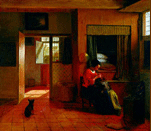










Plenary Two: Degree, Priority, and Place
|Plenary Speakers| |Workshops|
Early modern thinkers tended to see their society as a set of interlocking, analogically connected hierarchies, a paradigm that modern scholars of the period have often adopted. This plenary explores that paradigm by interrogating or dismantling the analogical connections structuring them. To what extent did one hierarchy allow women to transcend the limits placed upon them by other hierarchies? Just as gender divided women and men, women were differentiated from each other by ranked categories of age, race, class, and religion. How did women interact across these boundaries? To what extent and in what ways did class overpower gender? How did a dominant position—as, for instance, a mistress, a landowner, or a patron—in any one of these systems shape relations not only with other women but also with less powerful men? How did women navigate among competing claims for their obedience? What were the structural jurisdictions and capacities among groups at the lower end of the scale—servants, tenants, slaves, religious minorities?
|
|
|
||||||
|
|
 |
 |
|
||||
 |
|
 |
|
||||
|
|
|
||||||
|
|
|
||||||
 |
|
||||||
|
|
|
||||||
| |
|
||||||
 |
|
||||||
 |
|
||||||
 |
|
||||||
 |
|
||||||
|
|
|
||||||
|
|
 |
|
|
||||
 |
|
||||||
|
|
|
|
|
|
|
|
|